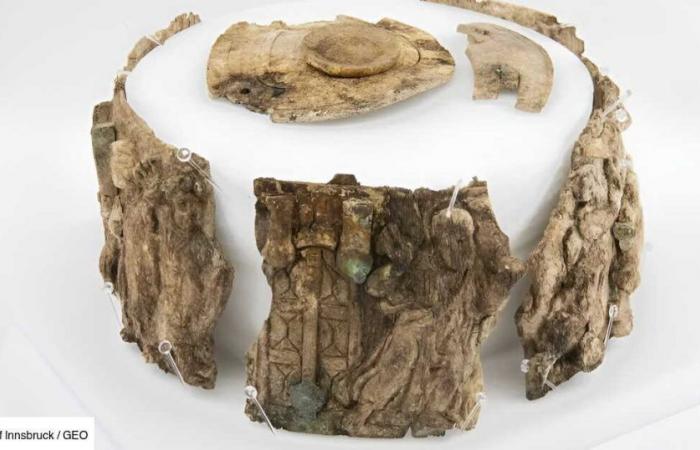This Christian artifact, consecrated as one of the most “holy” parts of a church, was usually one of the first taken away when the religious building was abandoned. Fragments of what once formed a pyxis, a round ivory vessel decorated with rich designs, have been found in southern Austria, to the delight of archaeologists – and once surely the dismay of its former owners, who left behind this valuable object in the 6th century.
According to researchers from the Austrian University of Innsbruck, who announced their discovery in a press release dated June 25, 2024, only around forty ivory boxes of this type are known in the world. Relics of this type are rare to be found in their original archaeological contexts. They are generally kept in the treasures of cathedrals or exhibited in museums. The last time a pyxis was identified during excavations dates back around a century.
The rest under this advertisement
Nature takes its time…
like this ad!
Nature takes its time…
like this ad!
Forgotten settlement from late antiquity
Austrian archaeologists have been excavating a hilltop settlement in late antiquity, Burgbichl, near Irschen (Carinthia, Austria), since 2016. From around the 4th century onwards, it became more common for settlements to be built on high ground, as they were easier to defend than those in valleys. “Towards the end of the Roman Empiretimes became more uncertain, especially in the outlying provinces of the empire, including the region that is today Austria.”explains Gerald Grabherr, member of the team behind the find.
“The year 610 marks a turning point”, he adds. Not far from the settlement of Irschen, a Slavic army confronts the Bavarian forces of the Baioarii. The victory, won by the Slavs, marks the region’s break with the ancient Mediterranean world. But also, with Christianity, since they bring their own pantheon of gods. The Burgbichl settlement was abandoned by its inhabitants.
The rest under this advertisement
Nature takes its time…
like this ad!
It was completely forgotten until 1,500 years later, when scientists put their noses in it – and more importantly, their hands. They documented several dwellings, two religious buildings, a cistern, old personal effects… But it was in the side chapel of a primitive church from the 5th-6th centuries, hidden under the altar, that they unearthed in 2022 the pieces of the famous pyxis, measuring about 20 centimeters by 30, the first to be discovered in its archaeological context in the country.
A very fragile unique ivory reliquary
The restoration of the reliquary, kept at the University of Innsbruck, has been a real challenge since its discovery: the ivory from which its fragments are made has tended to absorb moisture from its environment, the ground. It is therefore particularly fragile and easily damaged. “Uncontrolled drying can lead to shrinkage and cracking, causing irreparable damage.”adds Ulrike Töchterle, head of the restoration workshop, in the press release.
The rest under this advertisement
Nature takes its time…
like this ad!
Nature takes its time…
like this ad!
Once excavated, the rare artifact was thus exposed to a “risk of condensation and mold formation […] very high”. A drying process “very careful and prolonged” made it possible to preserve individual pieces for analysis. The deformation of the largest parts of the object, due to humidity, however, makes it impossible to reconstitute the pyxis in its original state. Scientists are currently working on a 3D reconstruction.
The decorations already observable on his remains represent a variety of biblical scenes. In one section, a man at the foot of a mountain sees himself receiving something from one hand. There is a representation of the delivery of the Ten Commandments to Moses on Mount Sinai. Another depicts a man on a chariot pulled by hand towards the sky. Experts assume that this is a depiction of the ascension of Christ. Gerald Grabherr explains to Newskeek:
The rest under this advertisement
Nature takes its time…
like this ad!
The representation of scenes from the Old Testament and their connection with scenes from the New Testament is typical of late Antiquity and therefore fits perfectly into our pyxis; however, the representation of the Ascension of Christ with a “bige” (they study in Latin) — a two-horse chariot — is very particular and hitherto unknown.
Close-ups of the pyxis. On the left, “Moses receives the commandments from the hand of God”. On the right, “Ascension of Christ on a carriage”. University of Innsbruck
Investigation of the pyxis: what did it contain?
It was initially assumed that the box contained sacred contents, perhaps the remains of a saint. The arrangement of the different shards in the reliquary nevertheless suggests that it was already broken at the end of Antiquity. Emptied, she would have been buried in this state under the altar. “The pyxis was probably also considered sacred and treated accordingly, since it was in contact with a relic. Its archaeological and historical importance cannot be denied.”underlines the archaeologist.
The rest under this advertisement
Nature takes its time…
like this ad!
Nature takes its time…
like this ad!
It was because it was considered particularly sacred that this type of reliquary was generally taken away when a church was abandoned – at least, in theory. Subsequently, these richly decorated box-shaped “vases” ended up being placed next to or suspended above the altar, where they were used to keep the Eucharistic reserve (the consecrated hosts) safe.
Investigations are continuing into the rare Christian artifact from Burgbichl, including its ivory – the origin of which researchers are trying to discover – its metal components, the remains of glue, etc. Found within it, wooden parts probably belonging to its closure, are also being analyzed. It is not completely excluded that these are the remains of a relic. Whatever the case, they could help experts to date the curious object more precisely.







